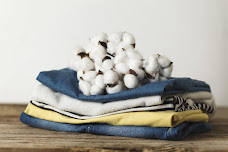Sustainable Materials - A Guide on What Fabrics to Look for
“Getting as much wear out of clothes is just as important as buying second hand”
Finding the right fabric is really important when shopping to ensure durability and longevity of your clothes. Not only is buying consciously important for sustainability but also maximising the wear of clothing to limit the amount of clothes that are in circulation. Finding the right material ensures a cyclical economy regarding fashion.
Bamboo
Bamboo is a fast growing plant meaning it does not need artificial fertilisers to grow meaning the source of the plant is sustainable. During its process the wood from the bamboo is crushed, then the enzyme-retted and washed to break down walls to get the fibre into a fabric for clothing. When made into fabric for clothing it is a soft and breathable fabric. It has been a popular material for socks due to its antibacterial properties meaning it limits body odour as well as its properties that make it good for people with sensitive skin.
Linen
Linen is an absolute summer staple because it actually keeps you cool and protected from the sun. This is because it is a quick drying material. Not only that but it is a sustainable material as it is a natural plant; its flax plant fibres means the material is biodegradable. Yet this is only when not dyed so choosing beige is better than opting for other colours such as bleached white. The natural material also means no microfibres are released into the water system when washing. Linen can easily be found in charity shops as well for as low as £1!
Hemp
This material dates back centuries as it's linked to marijuana - but it is not a drug as much of its reputation believes it to be. It was popularised in the 1950s and then met with stigma but now it is a sustainable material that is used a lot in street style. This is mainly due to its durability.
Organic Cotton
Cotton is a versatile material that can be made into a variety of clothing. Organic cotton focuses on the sustainability of the fabric by not using genetically modified plants or synthetic processes. Clothing that uses organic cotton are listed on the Better Cotton Initiative (BCI) which is 22% of world cotton production. BCI is a not-for-profit organisation has 2563 members, focusing on every aspect of the fashion industry including the farmers themselves. Organic cotton is non-wasteful as the cotton seeds are used as food and stalks for soil. Therefore, organic cotton is good for all - the workers, environment and the consumer as it can be made into multiple forms.
Cashmere
As winter is sticking around, cashmere should be mentioned-it is a timeless fabric that is suitable for all ages and will keep you warm all season. It is a natural occurring fabric which means it can decompose, not that it needs to because it is so durable and lovely to wear. With an increased demand however, methods of making cashmere clothing is becoming less sustainable so thrifting cashmere is great for the environment, and the bank account! Cashmere can be found on Vinted and charity shops.
Recycled Polyester
Whilst creating new articles with sustainable materials is eco-friendly, using material that is already in circulation and giving it a new life is also sustainable as well. It ensures a cyclical economy, ensuring no textile waste as it means polyester is diverted from landfill. Plastic is melted to make new yarn (mechanical) or the plastic molecules are broken down to make yarn (chemical). Recycled polyester means 45%-70% less CO2 is emitted during production compared to virgin polyester and its nicer on the bank account. However, microplastics can still be released as it is not biodegradable.





Comments
Post a Comment